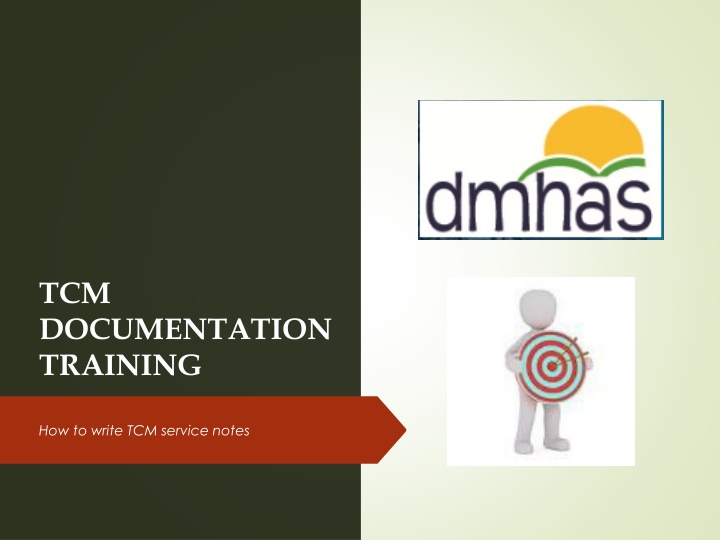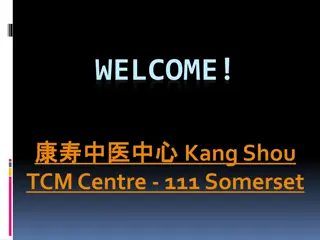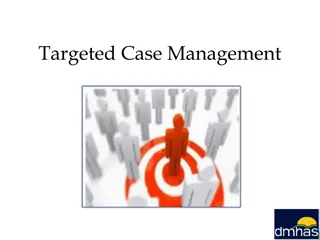Effective Strategies for Writing TCM Service Notes
Learn how to write comprehensive TCM service notes that meet documentation requirements, reflect medical necessity, and support financial sustainability. Understand the importance of good documentation, the golden thread of documentation, and key elements like assessment, recovery plans, and clear goals. Avoid common pitfalls in following the golden thread and ensure your documentation meets Medicaid program rules.
Download Presentation

Please find below an Image/Link to download the presentation.
The content on the website is provided AS IS for your information and personal use only. It may not be sold, licensed, or shared on other websites without obtaining consent from the author.If you encounter any issues during the download, it is possible that the publisher has removed the file from their server.
You are allowed to download the files provided on this website for personal or commercial use, subject to the condition that they are used lawfully. All files are the property of their respective owners.
The content on the website is provided AS IS for your information and personal use only. It may not be sold, licensed, or shared on other websites without obtaining consent from the author.
E N D
Presentation Transcript
TCM DOCUMENTATION TRAINING How to write TCM service notes
A Type of Service Supporting individuals in accessing needed services and supports (we ll get into the details in a bit). A Source of Funding What is Targeted Case Management? We provide many valuable services, but not all of them generate funding for our programs. Medicaid will provide funding for specific services we provide (this helps make our programs sustainable).
Qualified Providers must have training, experience TCM Providers expertise working with their target population.
For the Individuals we Serve To inform healthcare needs Evidence of our good work Protection from liability For ourselves Documentation: Why is it so important? For our Programs Financial sustainabili ty
What is Good Documentation ? Meets standards Detailed Specific to each service
Targeted Case Management Documentation Requirements Must meet Medicaid Program rules. Reflects medical necessity Current/active Recovery plan Thorough and detailed Correct billing codes
Golden Thread of Documentation Assessment Needs and diagnosis Recovery Plan Clear, measurable goals Encounter Note Services match recovery plan
Difficulty Following The Golden Thread Assessment deficits No recovery plan No baseline for progress Unrelated goals and objectives conversations vs interventions Progress notes do not assess behavior change No intervention specified
Information Gathering Relationship building Comprehensive Assessment of health and needs ASSESSMENTS History Current mental and physical health Financial Housing Educational Social Supports the necessity for the services you are providing.
Assessment Frequency Initial Assessment Annual assessment (or more often!) Document it! Conducting an assessment should be coded as a TCM.
Developed from the assessment Substantiate ongoing necessity for services Guide treatment A Recovery Plan is: Recovery Plans Individualized Goal-oriented Contains measurable objectives Promotes an enhanced quality of life Addresses the needs identified by the assessment. Illustrates treatment process from admission to discharge.
Recovery Plans are living documents, Update frequently Examples Recovery Plan Monitoring Change in individual s goals Hospitalization Change in health status Change in services Change in housing/employment/finances, etc. Document changes Recovery Plan monitoring is a TCM
Goals in Recovery Planning Person Centered Meaningful Hopeful Dreams and Desires Positive Not just symptom reduction Long-term, overarching and motivating to move towards something positive May take years to achieve
depressed But instead: What would they do if they were less depressed ? Example: I want to go back to school so I can be a good role model and provider to my children Goals should be Positively Stated Goals should be focused Goals in Recovery Planning In the individuals own words Reflected in quotes as I statements .
Takes time Requires a good relationship Difficult to articulate Challenges in Goal Setting Elicited through reflective listening Can be helpful to make suggestions
Goal Examples Instead of I want to be medication compliant ask what might be different if you were stable on your medication? A better goal might be If my medications work I can go back to school and finish my degree Instead of I want to stay out of jail by staying out of jail I want to get my job back at the construction company so I have money for a better apartment.
Think about it Beyond US and THEM but WE People with substance use disorders and mental health issues generally want the exact same things in life we all want. People want to thrive not just survive.
The Implications in Recovery Planning Documentation Which goal would you rather work on? Traditional Treatment Plan Goal Patient will achieve and maintain clinical stability and develop increased insight regarding substance use and assaultive behaviors Person-Centered Recovery Plan Goal I want family and friends back in my life
Objectives in Recovery Planning Breaking it down Objectives are the what- what is the next step towards completing the goal?
Creating SMART Objectives Specific, written an understandable language. Measurable; concrete change that is easily observed. Attainable; based on the client s desire and strengths and skills. Relevant; meaningful to the client and helps overcome a barrier to achieving a goal. Time-framed; achievable in a reasonable amount of time. (30 days, 60 days etc.)
A Coordination of Care objective is considered a Best Practice include the barrier that is preventing the client from accessing and utilizing the services on their own. Coordination of Care Objective Coordinating care should be coded as TCM
Interventions are the How- How are we going to do it? Interventions are the actions taken to achieve the objective- services provided by the case manager, or collateral resource. Interventions in Recovery Planning Interventions provided by the case manager should target completion of the plan objective and be documented in a way to support the necessity of the services you are providing.
What Do People Want in Life? Independence I want to control my own money. Housing I want to move out of the group home. Social activities I want to join a bowling league. Work /education I want to finish school Satisfying relationships I want to see my grandkids. Spiritual connection I want to get back to church. Valued Roles I want to volunteer at the Senior Center. Health/well-being I want to lose weight.
Objective Examples Karen (name) will have better control of her diabetes (improvement area)as evidenced by daily glucose readings of under 180 (accomplishing what achievement?) within the next 60 days. (time frame) Sam(name) will decrease his anxiety (improvement area) as evidenced by attending one activity weekly at the community social club (accomplishment) for the next 90 days.(time frame)
INTERVENTIONS Professional services should specify WHO: will provide the service, i.e., name and job title WHAT: The TITLE of the service, e.g., Health & Wellness Group WHEN: The SCHEDULE of the service, i.e., the time and day(s) WHY: The individualized INTENT/PURPOSE of service
Types of Interventions Examples include interventions such as; Psychotherapy, medication, and skill building. Self-help groups and peer run support Involvement in Church/spiritual groups Exercise and nutritional advice Developing a WRAP Plan Involvement in community/cultural activities
Miss Reynolds, licensed dietician(who) will provide nutritional consult and menus(what) 2x per month for the next 2 months(when) to reduce glucose readings and educate Karen on proper food choices.(why) Intervention Examples This case manager(who) will teach and reinforce with Sam, 3 anxiety reduction strategies(what) 1x per week for the next 90 days(when) to support community integration.(why)
Recovery Plans must be current in order to bill for TCM- don t let your Recovery Plans expire. Services to clients who do not have a Recovery Plan or the Recovery plan is expired should not be coded as TCM TCM Recovery Plan Tips Each time you monitor an objective on an active Recovery Plan-it should be coded as TCM Each time you revise and update the Recovery Plan it should be coded as TCM
For a Recovery Plan to be person-centered you need to document evidence of the client s degree of participation and agreement with the Recovery Plan. The best way to accomplish this is to have the client s signature and date on the plan. If the client is unavailable or refuses to sign, the Plan must include the case manager s detailed explanation of why the signature could not be obtained and refer to a specific progress note that explains why. Include documentation in the progress notes of your follow-up efforts to obtain the signature. Also include documentation that you offered a copy of the plan to the client and their response. TCM Recovery Plan TIPS
The Encounter Note The purpose of encounter notes is to provide an ongoing narrative of the interventions that have been utilized in your collaboration with the client. An encounter note records the client s progress in the small achievements towards reaching their long-term goal. They provide an overview of the work and the progress made that is used to document Recovery Plan updates.
The note should reflect back to an objective in the Recovery Plan The services you provide should be reasonably expected to improve an aspect of the client s condition. Designed to reduce or control symptoms Prevent relapse or hospitalization Improve or maintain current level of functioning.
The Narrative You are telling a story with specific details. The GIRP Format (all the elements of good documentation): G-oal; Tie the story back to a goal in the Recovery Plan. I-ntervention; Describe in detail what you did and why you provided the service R-esponse; Document the client s response to the intervention & the impact on the client s progress. P-lan; identify the focus of your next meeting. Sign with credentials, date, time and duration
Encounter Note Example Using the GIRP Format Goal: Mental Health Objective#2- medication management for depression Intervention: This case manager coordinated a medication management appointment with Dr. Suri at Bristol Hospital due to Bob s concerns about his new medication for his depression. Accompanied Bob to the appointment where Bob expressed, he was gaining weight and didn t like the way it made him feel. Dr. Suri let him know that these symptoms were common and usually went away within 4 weeks. He also encouraged Bob to try to eat healthier and exercise more to counteract any weight gain. Response: Bob was happy the Dr. felt his side effects would go away but he expressed he doesn t like to exercise. Plan: meet next Tuesday to look at adding some light physical activity to his daily routine. Carla Michaels, LPC, 6/10/21 start:10:13/end 10:45 33 min. total Psychiatrist office
GIRP Notes Helpful Tip It is considered a documentation Best Practice to enter your encounter note into the client s permanent record within one business day of providing the service. The longer you wait the more likely you are to forget important details. If you have to delay documenting, be sure to clearly differentiate between the date and time you are writing the note and the date and time of the event.
GIRP Notes Helpful Tip All documentation is open to scrutiny by employers, accreditation bodies, and federal and state reviewers and auditors. It is a best practice to conduct a self-audit. Select a random sample for a specific amount of time( ex.10% of all charts every 3 months) Do not audit your own charts to remove bias Use the results you find for improving compliance. There is no real value in conducting a self-audit unless discovered issues are resolved.
Documentation that supports Medical Necessity FOUND: Counselor assisted client in buying summer clothes. He said he needed new shoes with the warmer weather. Counselor transported him to Walmart and helped him learn how to use the price checker. He said he had a good time. CORRECTED: Counselor arranged a trip to store where client was able to purchase seasonally appropriate clothing. Client has a history of wearing clothing that is ill-fitting and inappropriate for the season. This counselor continues to monitor his symptoms in the community as he often exhibits this when he begins to decompensate which has resulted in several hospitalizations.
Which Services are TCM? Assisting individuals in accessing needed services What do they need? Information gathering to identify needs Assessment Creating a plan Recovery Planning Connecting with Services Coordination Making sure it all works Monitoring
OVERVIEW OF SERVICES Comprehensive Assessment and Periodic Reassessment Comprehensive Assessment and Periodic Reassessment of the individual s needs to determine the need for medical, educational, employment, social or other services. These assessment activities include: Using a standardized assessment tool to take the person s history Identify the person s needs and completing related documentation and; Gathering information from other sources such as family members, medical providers, social workers and educators to form a complete assessment of the person. Periodic assessments must be repeated at least annually to be considered active. (This is a Medicaid standard; You may do these more frequently in your setting)
Overview of Services Development and Periodic Revision of a Recovery Plan Development and periodic revision of a Recovery Plan based on the information collected through the assessment that: Specifies the goals and objectives to address the educational, employment, medical, social, and other services needed by the individual; Includes activities such as ensuring the active participation of the person to develop those goals; Identifies a course of action to respond to the assessed needs of the person *Recovery plans and must be reviewed and updated at least annually to reflect the accomplishments and changing needs to be considered active. Recovery plans may be modified as needed
Overview of Services Referral and Related Activities Through Collateral Contacts Collateral contacts (entities outside of your agency such as BRS, clinical team members, family members, employers) that are directly related to identifying the person s needs and care for the purposes of; Helping the person access services such as scheduling appointments for the person including: Activities that link the person with medical, social, employment, educational providers, or other programs and services that can provide needed services to address identified needs and achieve goals in the care plan.
Overview of Services Advocate For Services Identified In The Recovery Plan TCM providers advocate for the person served to receive the benefits identified and desired to help the person served obtain and maintain those services. They advocate for the person s preferences regarding community living options and resources. TCM providers break down barriers that keep the person from benefitting from all the community resources that are available to the community. TCM providers promote the person s self-advocacy and promote person-centered practices.
Overview of Services Monitoring and Follow-Up Activities Activities and contacts necessary to ensure the Recovery Plan is implemented and adequately addresses the person s needs, which may be with the person, family members, service providers or other entities and conducted as often as necessary, including at least one annual monitoring to determine if the following were met: Services are being furnished as described in the Recovery Plan Services in the Recovery Plan are adequate Changes in the need or status or the person are reflected in the plan Monitoring and follow-up activities include making necessary adjustments in the Recovery Plan and service arrangements with providers
TCM Service Codes DDAP TCM Codes: TCM01 face to face with client TCM02 on the phone with client TCM03 with collateral TCM04- Audio and Visual with the client There are 2 newTCM04 Location Codes that should also be used : Audio and Visual-client at home Audio and Visual-Client in other location if any other location is used it will result in the billing error Service Name and Service Location Mismatch
Documentation: Why is it so important? For the Individuals we serve To inform healthcare needs Communication with your team For accurate assessments and services For evidence of progress
Documentation: Why is it so important? For ourselves Evidence of our good work Makes our work easier Protection from liability
Documentation: Why is it so important? For our Programs Proof of services Record of progress Financial sustainability
THANK YOU!!! Carleen Zambetti For TCM and Documentation questions at carleen.Zambetti@ct.gov Visit the DMHAS TCM webpage at https://portal.ct.gov/DMHAS/Initiatives/DMHAS- Initiatives/TCM for resources including power points, billable diagnosis and TIP Sheets. Check back often as information is added and updated on a regular basis.























